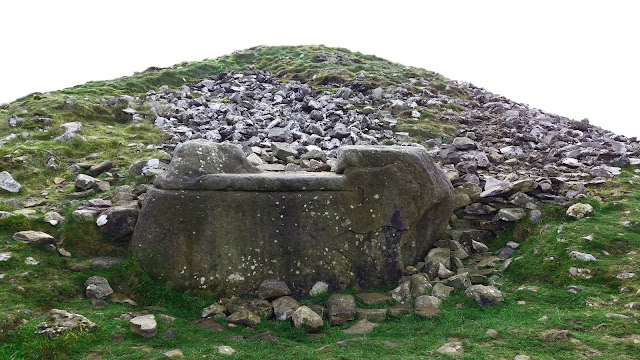Samhain: Goddesses Tlachtga & the Morrígan
By Ben Kesp
 |
| Loughcrew Cairns and the Hag's Chair |
The year is slowly dying and to mark its end is the ancient festival of Samhain or more commercially referred to as today, Halloween. The days pre and post the 31st of October signals the end of the harvest in the northern hemisphere, when the year enters its period of darkness, and the earth slumbers. There is no other place in Ireland or the world more associated with the festival of Samhain than at Tlachtga or the “Hill of Ward”, located near Athboy in Co. Meath, Ireland, but it also associated with the powerful and often seen as dark goddess of the Morrígan.
The Morrígan is a goddess I have never written about, nor do I intend to as I feel any post written on her would not do her justice due the complexity of her as a deity. She is a triple goddess, goddess of war, death and rebirth and is also the sovereign goddess of Ireland. When most other Irish gods and goddess transitioned to the new religion being spread by the Christian monks, the Morrígan, was lost, even possibly abandoned. The Dagda, or the father god, head of the Irish Pantheon of Gods was crucial in the introduction of the new religion.
 |
| Loughcrew Cairn Entrance |
 |
| One of the Loughcrew Cairns |
Ireland’s culture and belief systems had been very insular due to its isolation from mainland Europe and its strong ties with its former pagan culture. The development of the Irish church intertwined and fused the old pagan beliefs into the new religion with many crossovers with the gods of old. It appears to have been easier to Christianise and bestow saint hood on former gods than to have them removed altogether. All of the old pagan customs and rituals were based on earth’s seasonal cycles of the year and each is attributed to a related god, so as the seasons impacted the people, so did the god. Brigit is another such goddess to survive.
The relationship between the Dagda and the Morrígan is important also at Samhain. Before the Second Battle of Mag Tuired (Moytura) when the Tuatha Dé Danann (Irish Gods) were forced to fight their oppressors, the misshapen giants of the Fomorians, the Dagda set out and encountered the Morrígan, who informed him where to march his armies and meet with the opposing enemy. It was on the 31st of October, each year, the Dagda sleeps with the Morrígan to ensure the land of Ireland remains fertile for the coming spring. When it came time for battle, the Morrígan along with her two sisters, Badh and Macha, enter the battle in a frenzy striking fear into the enemy with their army of battle ravens and cast a thick wet mist over the battle field.
But what is relevant here if not what makes it different for the Morrígan in comparison to the other gods, is that she is not of the Danann line but was already in existence in Ireland before their arrival. She may have had an earlier cult following or have been closely connected to An Cailleach Bhéara who is indeed an interesting character in her right and may be seen as a connection between Irish ancient folklore and earth’s geological evolution. She is without doubt a complex figure, often depicting different cultural meanings like the dark side of Mother Earth, a deity at odds with mankind who has left her mark on the landscape and has been connected to many other Irish deities. Comparisons have been drawn between her and the Morrígan - perhaps they all encompass each other, shape shifting as the yearly seasons move over the landscape.
Returning to Samhain and the festival of Tlachtga, unfortunately, I won’t be in attendance this year at the annual festival in honour of the goddess. For those that remember last year, I posted my activity live as it happened. Firstly, travelling to the ancient site of Loughcrew Cairns and onto the Hags Chair (An Cailleach Bhéara), from there to the beautiful Slane Castle and onto the Hill of Slane, where St. Patrick lit the first paschal fire opposing the lighting of the first fire by the High King of Ireland on the Hill of Tara. The final stop for the day was at the Hill of Ward and to the festival of fire in honour of the Goddess Tlachtga.
 |
| Slane Castle |
 |
| Tlachtga - Festival of Fire (Samhain) |
 |
| Tlachtga - Festival of Fire (Samhain) |
It is great to see the festivals of fire still in operation in Ireland and enjoyed by so many. Another massive event each year is the festival of Bealtaine (Beltane) to mark the coming of summer held at the Hill of Uisneach (Centre or Naval of Ireland) each year.
So if you are visiting the Samhain festival or similar festivals this year do enjoy and share in these great experiences that connect us to our ancient heritage and past. Below are two videos from the 2018 ceremony on the Hill of Ward. Until next time – take care!


Comments
Post a Comment